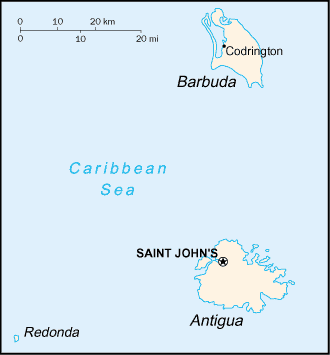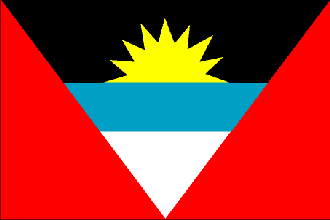
|
Antigua and Barbuda
Background:
The Siboney were the first to inhabit the islands of Antigua and Barbuda
in 2400 B.C., but Arawak and Carib Indians populated the islands when
Columbus landed on his second voyage in 1493. Early settlements by the
Spanish and French were succeeded by the English who formed a colony in
1667. Slavery, established to run the sugar plantations on Antigua, was
abolished in 1834. The islands became an independent state within the
British Commonwealth of Nations in 1981.
Location:
Caribbean, islands between the Caribbean Sea and the North Atlantic
Ocean,
east-southeast of Puerto Rico.
Total: 443 sq km (Antigua
280 sq km; Barbuda 161 sq km). Note: includes
Redonda, 1.6 sq km, land:
442 sq km.
2.5 times the size of Washington, DC.
Coastline: 153
km
Climate and Terrain:
Climate: Tropical marine; little seasonal temperature variation.
Terrain: Mostly low-lying limestone and coral islands, with some
higher volcanic areas.
Elevation extremes: lowest point: Caribbean
Sea 0 m, highest point: Boggy Peak 402 m.
People:
Population: 67,448 (July 2002 est.)
Ethnic groups: Black, British,
Portuguese, Lebanese, and Syrian.
Religions: Christian, (predominantly
Anglican with other Protestant, and some
Roman Catholic).
Languages: English (official), local dialects.
Government:
Government type: Constitutional monarchy with UK-style parliament.
Capital: Saint John's.
Independence: 1 November 1981 (from UK).
Economy overview:
Tourism continues to dominate the economy, accounting for more than half
of GDP. Weak tourist arrival numbers since early 2000 have slowed the economy,
however, and pressed the government into a tight fiscal corner. The dual-island
nation's agricultural production is focused on the domestic market and
constrained by a limited water supply and a labor shortage stemming from the
lure of higher wages in tourism and construction work. Manufacturing comprises
enclave-type assembly for export with major products being bedding,
handicrafts, and electronic components. Prospects for economic growth in the
medium term will continue to depend on income growth in the industrialized
world, especially in the US, which accounts for about one-third of all tourist
arrivals.
GDP - composition by sector: Agriculture: 4%, industry: 19%, services: 77%.
Statistics:
Telephones - main lines in use: 28,000.
Telephones - mobile cellular: 1,300.
Radio broadcast stations: AM 4, FM 2.
Radios: 36,000.
Television broadcast stations: 2.
Televisions: 31,000.
Internet users: 5,000.
Railways: Total: 77 km.
Highways: Total: 1,165 km, paved: 384 km, unpaved: 781 km.
Airports - with paved runways: 2, with unpaved runways: 1.
Return to Visiting Locations
|

